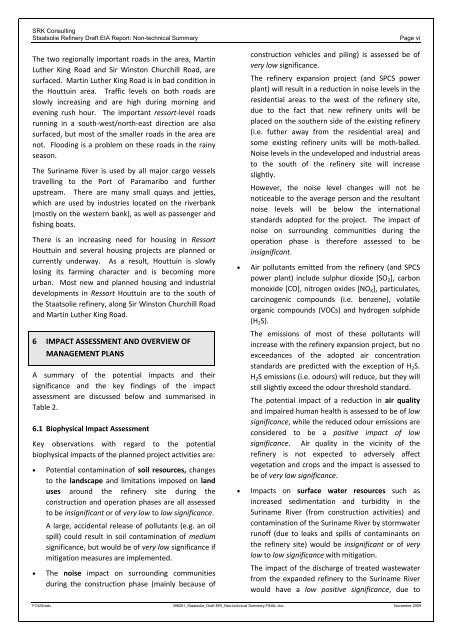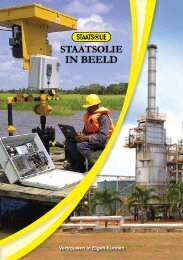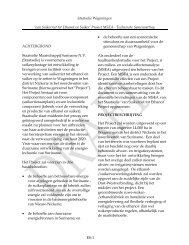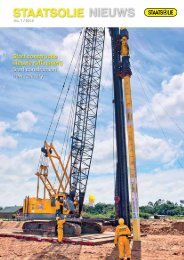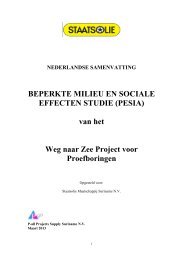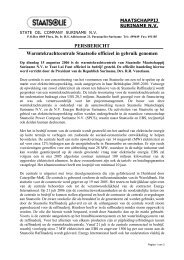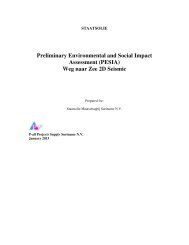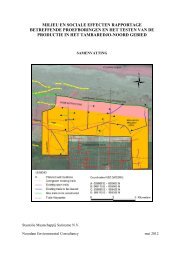English - Staatsolie
English - Staatsolie
English - Staatsolie
You also want an ePaper? Increase the reach of your titles
YUMPU automatically turns print PDFs into web optimized ePapers that Google loves.
SRK Consulting<br />
<strong>Staatsolie</strong> Refinery Draft EIA Report: Non-technical Summary Page vi<br />
The two regionally important roads in the area, Martin<br />
Luther King Road and Sir Winston Churchill Road, are<br />
surfaced. Martin Luther King Road is in bad condition in<br />
the Houttuin area. Traffic levels on both roads are<br />
slowly increasing and are high during morning and<br />
evening rush hour. The important ressort-level roads<br />
running in a south-west/north-east direction are also<br />
surfaced, but most of the smaller roads in the area are<br />
not. Flooding is a problem on these roads in the rainy<br />
season.<br />
The Suriname River is used by all major cargo vessels<br />
travelling to the Port of Paramaribo and further<br />
upstream. There are many small quays and jetties,<br />
which are used by industries located on the riverbank<br />
(mostly on the western bank), as well as passenger and<br />
fishing boats.<br />
There is an increasing need for housing in Ressort<br />
Houttuin and several housing projects are planned or<br />
currently underway. As a result, Houttuin is slowly<br />
losing its farming character and is becoming more<br />
urban. Most new and planned housing and industrial<br />
developments in Ressort Houttuin are to the south of<br />
the <strong>Staatsolie</strong> refinery, along Sir Winston Churchill Road<br />
and Martin Luther King Road.<br />
6 IMPACT ASSESSMENT AND OVERVIEW OF<br />
MANAGEMENT PLANS<br />
A summary of the potential impacts and their<br />
significance and the key findings of the impact<br />
assessment are discussed below and summarised in<br />
Table 2.<br />
6.1 Biophysical Impact Assessment<br />
Key observations with regard to the potential<br />
biophysical impacts of the planned project activities are:<br />
• Potential contamination of soil resources, changes<br />
to the landscape and limitations imposed on land<br />
uses around the refinery site during the<br />
construction and operation phases are all assessed<br />
to be insignificant or of very low to low significance.<br />
A large, accidental release of pollutants (e.g. an oil<br />
spill) could result in soil contamination of medium<br />
significance, but would be of very low significance if<br />
mitigation measures are implemented.<br />
• The noise impact on surrounding communities<br />
during the construction phase (mainly because of<br />
construction vehicles and piling) is assessed be of<br />
very low significance.<br />
The refinery expansion project (and SPCS power<br />
plant) will result in a reduction in noise levels in the<br />
residential areas to the west of the refinery site,<br />
due to the fact that new refinery units will be<br />
placed on the southern side of the existing refinery<br />
(i.e. futher away from the residential area) and<br />
some existing refinery units will be moth-balled.<br />
Noise levels in the undeveloped and industrial areas<br />
to the south of the refinery site will increase<br />
slightly.<br />
However, the noise level changes will not be<br />
noticeable to the average person and the resultant<br />
noise levels will be below the international<br />
standards adopted for the project. The impact of<br />
noise on surrounding communities during the<br />
operation phase is therefore assessed to be<br />
insignificant.<br />
• Air pollutants emitted from the refinery (and SPCS<br />
power plant) include sulphur dioxide [SO2], carbon<br />
monoxide [CO], nitrogen oxides [NOX], particulates,<br />
carcinogenic compounds (i.e. benzene), volatile<br />
organic compounds (VOCs) and hydrogen sulphide<br />
(H2S).<br />
The emissions of most of these pollutants will<br />
increase with the refinery expansion project, but no<br />
exceedances of the adopted air concentration<br />
standards are predicted with the exception of H2S.<br />
H2S emissions (i.e. odours) will reduce, but they will<br />
still slightly exceed the odour threshold standard.<br />
The potential impact of a reduction in air quality<br />
and impaired human health is assessed to be of low<br />
significance, while the reduced odour emissions are<br />
considered to be a positive impact of low<br />
significance. Air quality in the vicinity of the<br />
refinery is not expected to adversely affect<br />
vegetation and crops and the impact is assessed to<br />
be of very low significance.<br />
• Impacts on surface water resources such as<br />
increased sedimentation and turbidity in the<br />
Suriname River (from construction activities) and<br />
contamination of the Suriname River by stormwater<br />
runoff (due to leaks and spills of contaminants on<br />
the refinery site) would be insignificant or of very<br />
low to low significance with mitigation.<br />
The impact of the discharge of treated wastewater<br />
from the expanded refinery to the Suriname River<br />
would have a low positive significance, due to<br />
FOUD/dalc 398251_<strong>Staatsolie</strong>_Draft EIR_Non-technical Summary FINAL.doc November 2009


